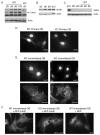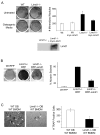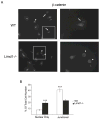The LIM protein LIMD1 influences osteoblast differentiation and function
- PMID: 18657804
- PMCID: PMC2570157
- DOI: 10.1016/j.yexcr.2008.06.003
The LIM protein LIMD1 influences osteoblast differentiation and function
Abstract
The balance between bone resorption and bone formation involves the coordinated activities of osteoblasts and osteoclasts. Communication between these two cell types is essential for maintenance of normal bone homeostasis; however, the mechanisms regulating this cross talk are not completely understood. Many factors that mediate differentiation and function of both osteoblasts and osteoclasts have been identified. The LIM protein Limd1 has been implicated in the regulation of stress osteoclastogenesis through an interaction with the p62/sequestosome protein. Here we show that Limd1 also influences osteoblast progenitor numbers, differentiation, and function. Limd1(-/-) calvarial osteoblasts display increased mineralization and accelerated differentiation. While no significant differences in osteoblast number or function were detected in vivo, bone marrow stromal cells isolated from Limd1(-/-) mice contain significantly more osteoblast progenitors compared to wild type controls when cultured ex vivo. Furthermore, we observed a significant increase in nuclear beta-catenin staining in differentiating Limd1(-/-) calvarial osteoblasts suggesting that Limd1 is a negative regulator of canonical Wnt signaling in osteoblasts. These results demonstrate that Limd1 influences not only stress osteoclastogenesis but also osteoblast function and osteoblast progenitor commitment. Together, these data identify Limd1 as a novel regulator of both bone osetoclast and bone osteoblast development and function.
Figures






Similar articles
-
The LIM protein, Limd1, regulates AP-1 activation through an interaction with Traf6 to influence osteoclast development.J Biol Chem. 2007 Jan 5;282(1):39-48. doi: 10.1074/jbc.M607399200. Epub 2006 Nov 8. J Biol Chem. 2007. PMID: 17092936
-
FHL2 mediates dexamethasone-induced mesenchymal cell differentiation into osteoblasts by activating Wnt/beta-catenin signaling-dependent Runx2 expression.FASEB J. 2008 Nov;22(11):3813-22. doi: 10.1096/fj.08-106302. Epub 2008 Jul 24. FASEB J. 2008. PMID: 18653765
-
Dietary-induced serum phenolic acids promote bone growth via p38 MAPK/β-catenin canonical Wnt signaling.J Bone Miner Res. 2010 Nov;25(11):2399-411. doi: 10.1002/jbmr.137. J Bone Miner Res. 2010. PMID: 20499363
-
Regulation of bone development and maintenance by Runx2.Front Biosci. 2008 Jan 1;13:898-903. doi: 10.2741/2730. Front Biosci. 2008. PMID: 17981598 Review.
-
Signaling networks that control the lineage commitment and differentiation of bone cells.Crit Rev Eukaryot Gene Expr. 2009;19(1):1-46. doi: 10.1615/critreveukargeneexpr.v19.i1.10. Crit Rev Eukaryot Gene Expr. 2009. PMID: 19191755 Free PMC article. Review.
Cited by
-
Deletion of BMP receptor type IB decreased bone mass in association with compromised osteoblastic differentiation of bone marrow mesenchymal progenitors.Sci Rep. 2016 Apr 6;6:24256. doi: 10.1038/srep24256. Sci Rep. 2016. PMID: 27048979 Free PMC article.
-
Multi-omics Data Integration for Identifying Osteoporosis Biomarkers and Their Biological Interaction and Causal Mechanisms.iScience. 2020 Feb 21;23(2):100847. doi: 10.1016/j.isci.2020.100847. Epub 2020 Jan 17. iScience. 2020. PMID: 32058959 Free PMC article.
-
Imputation of canine genotype array data using 365 whole-genome sequences improves power of genome-wide association studies.PLoS Genet. 2019 Sep 16;15(9):e1008003. doi: 10.1371/journal.pgen.1008003. eCollection 2019 Sep. PLoS Genet. 2019. PMID: 31525180 Free PMC article.
-
Algorithm-Based Meta-Analysis Reveals the Mechanistic Interaction of the Tumor Suppressor LIMD1 With Non-Small-Cell Lung Carcinoma.Front Oncol. 2021 Mar 31;11:632638. doi: 10.3389/fonc.2021.632638. eCollection 2021. Front Oncol. 2021. PMID: 33869018 Free PMC article.
-
LIMD1 Increases the Sensitivity of Lung Adenocarcinoma Cells to Cisplatin via the GADD45α/p38 MAPK Signaling Pathway.Front Oncol. 2020 Jul 10;10:969. doi: 10.3389/fonc.2020.00969. eCollection 2020. Front Oncol. 2020. PMID: 32754438 Free PMC article.
References
-
- Roodman GD. Regulation of osteoclast differentiation. Ann N Y Acad Sci. 2006;1068:100–9. - PubMed
-
- Rogers A, Eastell R. Circulating osteoprotegerin and receptor activator for nuclear factor kappaB ligand: clinical utility in metabolic bone disease assessment. J Clin Endocrinol Metab. 2005;90:6323–31. - PubMed
-
- Kiss H, Kedra D, Yang Y, Kost-Alimova M, Kiss C, O’Brien KP, Fransson I, Klein G, Imreh S, Dumanski JP. A novel gene containing LIM domains (LIMD1) is located within the common eliminated region 1 (C3CER1) in 3p21.3. Hum Genet. 1999;105:552–9. - PubMed
-
- Crawford AW, Beckerle MC. Purification and characterization of zyxin, an 82,000-dalton component of adherens junctions. J Biol Chem. 1991;266:5847–53. - PubMed
-
- Petit MM, Mols R, Schoenmakers EF, Mandahl N, Van de Ven WJ. LPP, the preferred fusion partner gene of HMGIC in lipomas, is a novel member of the LIM protein gene family. Genomics. 1996;36:118–29. - PubMed
Publication types
MeSH terms
Substances
Grants and funding
LinkOut - more resources
Full Text Sources
Molecular Biology Databases

